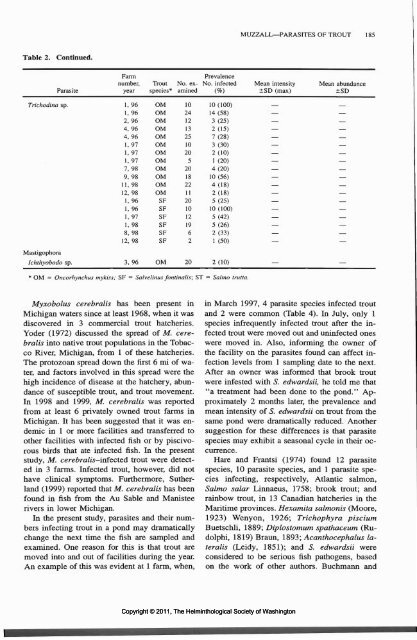Comparative Parasitology 67(2) 2000 - Peru State College
Comparative Parasitology 67(2) 2000 - Peru State College
Comparative Parasitology 67(2) 2000 - Peru State College
You also want an ePaper? Increase the reach of your titles
YUMPU automatically turns print PDFs into web optimized ePapers that Google loves.
Table 2. Continued.<br />
Parasite<br />
Trichodina sp.<br />
Mastigophora<br />
Ichthyobodo sp.<br />
Farm<br />
number,<br />
year<br />
1, 96<br />
1, 96<br />
2, 96<br />
4, 96<br />
4, 96<br />
1, 97<br />
1, 97<br />
1, 97<br />
7, 98<br />
9, 98<br />
11, 98<br />
12, 98<br />
1, 96<br />
1, 96<br />
1, 97<br />
1, 98<br />
8, 98<br />
12, 98<br />
3, 96<br />
Trout<br />
species*<br />
OM<br />
OM<br />
OM<br />
OM<br />
OM<br />
OM<br />
OM<br />
OM<br />
OM<br />
OM<br />
OM<br />
OM<br />
SF<br />
SF<br />
SF<br />
SF<br />
SF<br />
SF<br />
OM<br />
No. examined<br />
10<br />
24<br />
12<br />
13<br />
25<br />
10<br />
20<br />
5<br />
20<br />
18<br />
22<br />
11<br />
20<br />
10<br />
12<br />
19<br />
6<br />
2<br />
20<br />
MUZZALL—PARASITES OF TROUT 185<br />
Prevalence<br />
No. infected Mean intensity<br />
(%) ±SD (max)<br />
10 (100) —<br />
14 (58)<br />
3 (25)<br />
2(15)<br />
7(28)<br />
3 (30)<br />
2(10)<br />
1 (20)<br />
4 (20)<br />
10 (56)<br />
4(18)<br />
2(18)<br />
5 (25)<br />
10 (100)<br />
5 (42)<br />
5 (26)<br />
2(33)<br />
1 (50)<br />
2 (10) —<br />
OM = Oncorhynchus mykiss; SF = Salvelinus fontinalis; ST = Salmo trutta.<br />
Myxobolus cerebralis has been present in<br />
Michigan waters since at least 1968, when it was<br />
discovered in 3 commercial trout hatcheries.<br />
Yoder (1972) discussed the spread of M. cerebralis<br />
into native trout populations in the Tobacco<br />
River, Michigan, from 1 of these hatcheries.<br />
The protozoan spread down the first 6 mi of water,<br />
and factors involved in this spread were the<br />
high incidence of disease at the hatchery, abundance<br />
of susceptible trout, and trout movement.<br />
In 1998 and 1999, M. cerebralis was reported<br />
from at least 6 privately owned trout farms in<br />
Michigan. It has been suggested that it was endemic<br />
in 1 or more facilities and transferred to<br />
other facilities with infected fish or by piscivorous<br />
birds that ate infected fish. In the present<br />
study, M. cerebralis-infected trout were detected<br />
in 3 farms. Infected trout, however, did not<br />
have clinical symptoms. Furthermore, Sutherland<br />
(1999) reported that M. cerebralis has been<br />
found in fish from the Au Sable and Manistee<br />
rivers in lower Michigan.<br />
In the present study, parasites and their numbers<br />
infecting trout in a pond may dramatically<br />
change the next time the fish are sampled and<br />
examined. One reason for this is that trout are<br />
moved into and out of facilities during the year.<br />
An example of this was evident at 1 farm, when,<br />
Mean abundance<br />
±SD<br />
—<br />
—<br />
—<br />
—<br />
—<br />
—<br />
—<br />
—<br />
—<br />
—<br />
—<br />
—<br />
—<br />
—<br />
—<br />
—<br />
—<br />
in March 1997, 4 parasite species infected trout<br />
and 2 were common (Table 4). In July, only 1<br />
species infrequently infected trout after the infected<br />
trout were moved out and uninfected ones<br />
were moved in. Also, informing the owner of<br />
the facility on the parasites found can affect infection<br />
levels from 1 sampling date to the next.<br />
After an owner was informed that brook trout<br />
were infested with S. edwardsii, he told me that<br />
"a treatment had been done to the pond." Approximately<br />
2 months later, the prevalence and<br />
mean intensity of S. edwardsii on trout from the<br />
same pond were dramatically reduced. Another<br />
suggestion for these differences is that parasite<br />
species may exhibit a seasonal cycle in their occurrence.<br />
Hare and Frantsi (1974) found 12 parasite<br />
species, 10 parasite species, and 1 parasite species<br />
infecting, respectively, Atlantic salmon,<br />
Salmo solar Linnaeus, 1758; brook trout; and<br />
rainbow trout, in 13 Canadian hatcheries in the<br />
Maritime provinces. Hexamita salmonis (Moore,<br />
1923) Wenyon, 1926; Trichophyra piscium<br />
Buetschli, 1889; Diplostomum spathaceum (Rudolphi,<br />
1819) Braun, 1893; Acanthocephalus later<br />
alls (Leidy, 1851); and S. edwardsii were<br />
considered to be serious fish pathogens, based<br />
on the work of other authors. Buchmann and<br />
Copyright © 2011, The Helminthological Society of Washington<br />
—

















